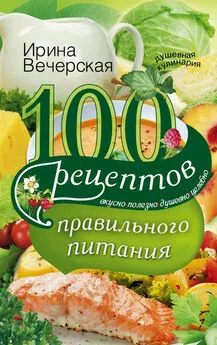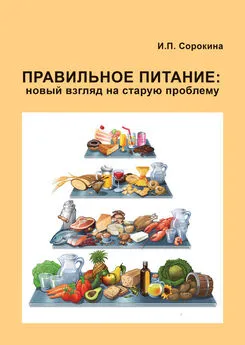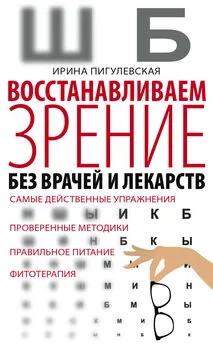Ирина Брехт - Правильное питание как минное поле
- Название:Правильное питание как минное поле
- Автор:
- Жанр:
- Издательство:ООО «ЛитРес», www.litres.ru
- Год:2019
- ISBN:нет данных
- Рейтинг:
- Избранное:Добавить в избранное
-
Отзывы:
-
Ваша оценка:
Ирина Брехт - Правильное питание как минное поле краткое содержание
Правильное питание как минное поле - читать онлайн бесплатно ознакомительный отрывок
Интервал:
Закладка:
82. Davidson TL, Swithers SE. A Pavlovian approach to the problem of obesity. Int J Obes Relat Metab Disord. 2004 Jul;28(7):933—5.
83. U.S. Food and Drug Administration. High-Intensity Sweeteners (2014).
84. Thornton SN. Increased Hydration Can Be Associated with Weight Loss. Frontiers in Nutrition. 2016;3:18. doi:10.3389/fnut.2016.00018.
85. Painter SL, Ahmed R, Hill JO, et al. What Matters in Weight Loss? An In-Depth Analysis of Self-Monitoring. Eysenbach G, ed. Journal of Medical Internet Research. 2017;19(5):e160. doi:10.2196/jmir.7457.
86. Richardson CR, Newton TL, Abraham JJ, Sen A, Jimbo M, Swartz AM. A Meta-Analysis of Pedometer-Based Walking Interventions and Weight Loss. Annals of Family Medicine. 2008;6(1):69–77. doi:10.1370/afm.761.
87. Tudor-Locke C, Craig CL, Brown WJ, et al. How many steps/day are enough? for adults. The International Journal of Behavioral Nutrition and Physical Activity. 2011;8:79. doi:10.1186/1479—5868—8-79.
88. Zijlstra N, de Wijk RA, Mars M, Stafleu A, de Graaf C. Effect of bite size and oral processing time of a semisolid food on satiation. Am J Clin Nutr. 2009 Aug; 90(2):269—75.
89. Steenhuis I., Vermeer W. Portion size: Review and framework for interventions. International Journal of Behavioral Nutrition and Physical Activity. 2009;6:58.
90. Ello-Martin JA et al. Dietary energy density in the treatment of obesity: a year-long trial comparing 2 weight-loss diets. Am J Clin Nutr. 2007 Jun;85(6):1465—77.
91. Rolls BJ et al. Provision of foods differing in energy density affects long-term weight loss. Obes Res. 2005 Jun;13(6):1052—60.
92. Rolls BJ et al. Portion size can be used strategically to increase vegetable consumption in adults. American Journal of Clinical Nutrition (2010), 91(4), 913–922.
93. Flood-Obbagy JE et al. The effect of fruit in different forms on energy intake and satiety at a meal. Appetite (2009), 52(2), 416–422.
94. Flood JE et al. Soup preloads in a variety of forms reduce meal energy intake. Appetite (2007), 49(3), 626–634.
95. Rolls BJ et al. Salad and satiety: Energy density and portion size of a first course salad affect energy intake at lunch. Journal of the American Dietetic Association (2004), 104(10), 1570–1576.
Часть 3. Глава 17.
1. Harvie M and A Howell. Potential Benefits and Harms of Intermittent Energy Restriction and Intermittent Fasting Amongst Obese, Overweight and Normal Weight Subjects-A Narrative Review of Human and Animal Evidence. Behav Sci (Basel). (2017) 7(1).
2. Rothschild J, Hoddy KK, Jambazian P, Varady KA. Time-restricted feeding and risk of metabolic disease: a review of human and animal studies. Nutr Rev. 2014 May;72(5):308—18. doi: 10.1111/nure.12104.
3. Varady KA Intermittent versus daily calorie restriction: which diet regimen is more effective for weight loss? Obes Rev. (2011) 12(7):e593—601.
4. Byrne, NM et. al. Intermittent energy restriction improves weight loss efficiency in obese men: the MATADOR study. Int J Obes (2017).
5. Seimon RV et al. Do intermittent diets provide physiological benefits over continuous diets for weight loss? A systematic review of clinical trials. Mol Cell Endocrinol. 2015 Dec 15;418 Pt 2:153—72.
6. Headland M, Clifton PM, Carter S, Keogh JB. Weight-Loss Outcomes: A Systematic Review and Meta-Analysis of Intermittent Energy Restriction Trials Lasting a Minimum of 6 Months. Nutrients. 2016;8(6):354. doi:10.3390/nu8060354
7. Harvie, MN et. al. The effects of intermittent or continuous energy restriction on weight loss and metabolic disease
8. risk markers: a randomised trial in young overweight women. Int J Obes (Lond). (2011) 35(5): 714—727
9. Hoddy KK, Kroeger CM, Trepanowski JF, Barnosky AR, Bhutani S, Varady KA. Safety of alternate day fasting and effect on disordered eating behaviors. Nutrition Journal. 2015;14:44. doi:10.1186/s12937—015—0029—9
Часть 3. Глава 18.
1. Tate DF, Wing RR, Winett RA. Using Internet technology to deliver a behavioral weight loss program. JAMA. 2001;285:1172–1177.
2. Yon BA, Johnson RK, Harvey-Berino J, Gold BC, Howard AB. Personal digital assistants are comparable to traditional diaries for dietary self-monitoring during a weight loss program. J Behav Med. 2007;30:165–175.
3. Shay LE, Seibert D, Watts D, Sbrocco T, Pagliara C. Adherence and weight loss outcomes associated with food-exercise diary preference in a military weight management program. Eat Behav. 2009;10:220–227.
4. Boutelle KN, Kirschenbaum DS. Further support for consistent self-monitoring as a vital component of successful weight control. Obes Res. 1998;6:219–224.
5. Baker RC, Kirschenbaum DS. Weight control during the holidays: highly consistent self-monitoring as a potentially useful coping mechanism. Health Psychol. 1998;17:367–370.
6. Benedik E et al. Comparison of paper- and web-based dietary records: a pilot study. Ann Nutr Metab. 2014; 64(2):156—66.
7. Thompson FE et al. Need for technological innovation in dietary assessment. J Am Diet Assoc. 2010 Jan; 110(1):48–51.
8. Zaidan S, Roehrer E. Popular Mobile Phone Apps for Diet and Weight Loss: A Content Analysis. Eysenbach G, ed. JMIR mHealth and uHealth. 2016;4(3):e80. doi:10.2196/mhealth.5406
9. World Health Organisation. Healthy diet. Fact sheet № 394 (2015).
10. Vadiveloo M, Sacks FM, Champagne CM, Bray GA, Mattei J. Greater Healthful Dietary Variety Is Associated with Greater 2-Year Changes in Weight and Adiposity in the Preventing Overweight Using Novel Dietary Strategies (POUNDS Lost) Trial. The Journal of Nutrition. 2016;146(8):1552–1559. doi:10.3945/jn.115.224683.
11. Raynor HA, Jeffery RW, Tate DF, Wing RR. Relationship between changes in food group variety, dietary intake, and weight during obesity treatment. Int J Obes Relat Metab Disord. 2004 Jun;28(6):813—20
12. Ducrot P, Méjean C, Aroumougame V, et al. Meal planning is associated with food variety, diet quality and body weight status in a large sample of French adults. The International Journal of Behavioral Nutrition and Physical Activity. 2017;14:12. doi:10.1186/s12966—017—0461—7.
13. Davoodi SH, Ajami M, Ayatollahi SA, Dowlatshahi K, Javedan G, Pazoki-Toroudi HR. Calorie Shifting Diet Versus Calorie Restriction Diet: A Comparative Clinical Trial Study. International Journal of Preventive Medicine. 2014;5(4):447–456.
14. Kresta JY, Byrd M, Oliver JM, et al. Effects of diet cycling on weight loss, fat loss and resting energy expenditure in women. Journal of the International Society of Sports Nutrition. 2010;7(Suppl 1):P21. doi:10.1186/1550—2783—7-S1-P21.
15. Friedl KE et al. Endocrine markers of semistarvation in healthy lean men in a multistressor environment. J Appl Physiol (1985). 2000 May;88(5):1820—30.
16. Mcdonald L. The Woman’s Book: A Guide to Nutrition, Fat Loss and Muscle Gain (2017), ISBN: 978—0-9671456—9–3, ch. 21, p.220—224
17. Pirke KM et al. Dieting causes menstrual irregularities in normal weight young women through impairment of episodic luteinizing hormone secretion. Fertil Steril. 1989 Feb;51(2):263—8.
18. de Castro JM. Weekly rhythms of spontaneous nutrient intake and meal pattern of humans. Physiol Behav. 1991 Oct;50(4):729—38.
19. Mcdonald L. The Woman’s Book: A Guide to Nutrition, Fat Loss and Muscle Gain (2017), ISBN: 978—0-9671456—9–3, ch. 12, p.111—114
20. Wing RR, Jeffery RW. Prescribed «breaks» as a means to disrupt weight control efforts. Obes Res. 2003 Feb;11(2):287—91.
Часть 4. Глава 20.
1. Pachucki M et al. Eating with others and meal location are differentially associated with nutrient intake by sex: The Diabetes Study of Northern California (DISTANCE). Appetite, 2018. DOI: 10.1016/j.appet.2018.03.020
2. Swinburn B, Egger G, Raza F. Dissecting obesogenic environments: the development and application of a framework for identifying and prioritizing environmental interventions for obesity. Prev Med. 1999 Dec; 29(6 Pt 1):563—70.
3. Diliberti N, Bordi PL, Conklin MT, Roe LS, Rolls BJ. Increased portion size leads to increased energy intake in a restaurant meal. Obes Res. 2004 Mar;12(3):562—8.
4. Clemens LH, Slawson DL, Klesges RC. The effect of eating out on quality of diet in premenopausal women. J Am Diet Assoc. 1999 Apr;99(4):442—4.
5. McCrory MA, Fuss PJ, Hays NP, Vinken AG, Greenberg AS, Roberts SB. Overeating in America: Association between restaurant food consumption and body fatness in healthy adult men and women aged 19 to 80. Obes Res. 1999 Nov;7(6):564—71.
6. Timmerman GM. Restaurant eating in nonpurge binge-eating women. West J Nurs Res. 2006 Nov;28(7):811—24. discussion 825—30.
7. Timmerman GM, Brown A. The Effect of a Mindful Restaurant Eating Intervention on Weight Management in Women. Journal of Nutrition Education and Behavior. 2012;44(1):22–28. doi:10.1016/j.jneb.2011.03.143.
8. Ducrot P, Méjean C, Aroumougame V, et al. Meal planning is associated with food variety, diet quality and body weight status in a large sample of French adults. The International Journal of Behavioral Nutrition and Physical Activity. 2017;14:12. doi:10.1186/s12966—017—0461—7.
Часть 4. Глава 21.
1. Rolls BJ, Rowe EA, Rolls ET, Kingston B, Megson A, Gunary R. Variety in a meal enhances food intake in man. Physiol Behav. 1981 Feb; 26(2): 215–221.
2. Hetherington M., HavermansR.C. Satiation, Satiety and the Control of Food Intake. Woodhead Publishing Series in Food Science, Technology and Nutrition 2013, Pages 253–269. doi.org/10.1533/9780857098719.4.253
3. Tai MM, Castillo P, Pi-Sunyer FX. Meal size and frequency: effect on the thermic effect of food. Am J Clin Nutr. 1991 Nov;54(5):783—7.
4. Arthur I Cederbaum, PhD. ALCOHOL METABOLISM. Clin Liver Dis. 2012 Nov; 16(4): 667–685. doi: 10.1016/j.cld.2012.08.002
5. Shelmet JJ, Reichard GA, Skutches CL, Hoeldtke RD, Owen OE, Boden G. Ethanol causes acute inhibition of carbohydrate, fat, and protein oxidation and insulin resistance. Journal of Clinical Investigation. 1988;81(4):1137–1145.
6. Yeomans MR. Alcohol, appetite and energy balance: is alcohol intake a risk factor for obesity? Physiol Behav. 2010 Apr 26;100(1):82—9. doi: 10.1016/j.physbeh.2010.01.012. Epub 2010 Jan 22.
7. Yeomans MR, Caton S, Hetherington MM. Alcohol and food intake. Curr Opin Clin Nutr Metab Care. 2003 Nov;6(6):639—44.
8. Stautz K et al. Does self-control modify the impact of interventions to change alcohol, tobacco, and food consumption? A systematic review. Health Psychol Rev. 2018 Jun;12(2):157–178. doi: 10.1080/17437199.2017.1421477. Epub 2018 Jan 11.
Часть 4. Глава 22.
1. Schoeller DA. The effect of holiday weight gain on body weight. Physiol Behav. 2014 Jul;134:66—9. doi: 10.1016/j.physbeh.2014.03.018. Epub 2014 Mar 21.
2. Yanovski JA, Yanovski SZ, Sovik KN, Nguyen TT, O’Neil PM, Sebring NG. A Prospective Study of Holiday Weight Gain. The New England journal of medicine. 2000;342(12):861–867. doi:10.1056/NEJM200003233421206.
3. Yanovski JA, Yanovski SZ, Sovik KN, Nguyen TT, O’Neil PM, Sebring NG. A prospective study of holiday weight gain. N Engl J Med. 2000 Mar 23; 342(12): 861–867.
4. Helander EE, Wansink B, Chieh A. Weight Gain over the Holidays in Three Countries. N Engl J Med. 2016 Sep 22; 375(12): 1200–1202.
5. Martins CM, Vallen B. The impact of holiday eating cues on self-regulatory bolstering for dieters and non-dieters. Psychol Health. 2014;29(9):999—1013
6. Rolls BJ, Rolls ET, Rowe EA, Sweeney K. Sensory specific satiety in man. Physiol Behav. 1981 Jul;27(1):137—42.
Читать дальшеИнтервал:
Закладка:








![Артем Каменистый - Правильное питание [СИ]](/books/1146496/artem-kamenistyj-pravilnoe-pitanie-si.webp)

